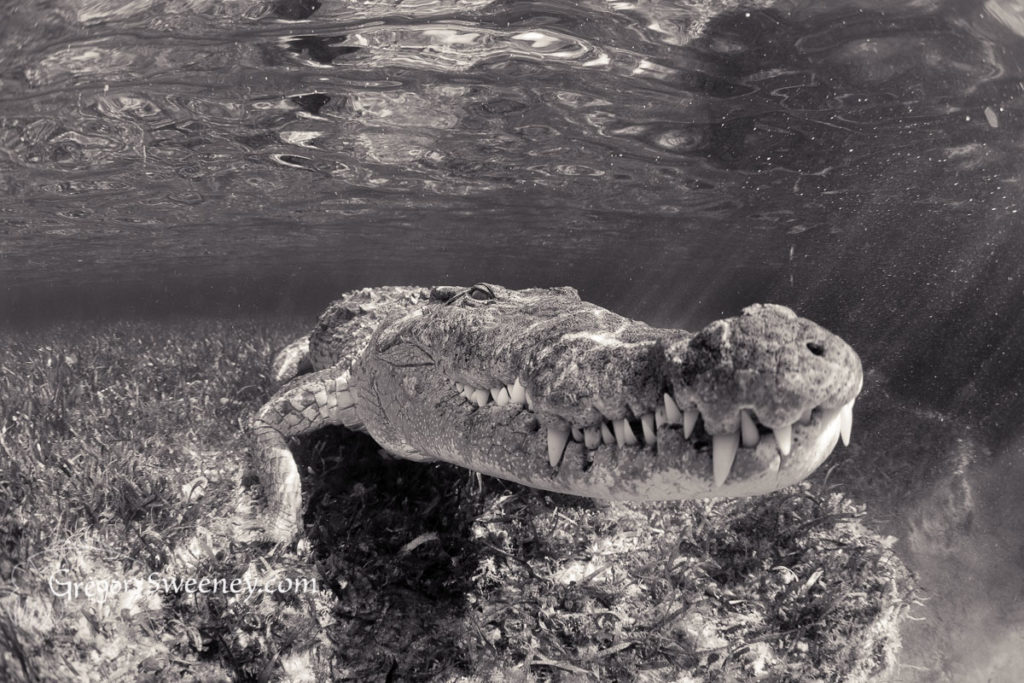
Photographing American Crocodiles at Banco Chinchorro, Quintana Roo, Mexico (Cancun area) 2019
With Reef diving at Chinchorro
When is my next trip to Chinchorro for Crocs? Visit my Website for trip details

This was my 3rd trip to Banco Chinchorro for crocodiles, but for all my guests this was their first encounter so close to reptile predators.
This is a place few people have been to and a chance to see and photograph pristine Caribbean reefs and also get close to the rare and endangered American Crocodile.

Summary:

Chinchorro Atoll (Banco Chinchorro Biosphere Reserve) is the best place in the world to get close to American crocodiles. It is located south of Cancun, Mexico and near the Belize border. The Banco Chinchorro Biosphere Reserve is the largest stand – alone reef in the Northern hemisphere and one of the healthiest. Currently only 1,928 hectares of the 144k hectares are zoned for diving and fewer than one thousand divers get to see these remote and unspoiled dive sites per year. It teems with fish and other sea life, and contains more than 100 shipwrecks as well as the largest population of American crocodiles found in the Americas.

The weather was very nice and calm for our visit. We started at the beautiful beachside resort in Xcalak for some amazing dives. The reefs are healthy and colorful with many fish. Again this year we found ourselves diving with manatees who were not afraid to approach us.

We made the crossing to Chinchorro on our 3rd day in Xcalak. The water was smooth on the way out. At the fish huts we found that the water would change from a tea green hue to a clear blue color depending on the tide level.


This is a safe encounter with guides who have done years of experimentation and careful planning to make this safe. Our outfitter and guides in Xcalak: XTC Dive Center, were the first operator to organize croc encounters in Chinchorro and they remain the only dive operator with an official concession. They are committed to sustainable tourism and conservation. This year they were training a new guide to work with the guests and crocodiles.
Camera Equipment
My primary lens for the underwater images was the 15mm 2.8 fisheye. I also had with me my 17 – 40mm lens which I used primarily for topside images, but used on at least one session underwater. My lens choices had to be balanced against limited space/weight and what I need and prefer for the whale sharks.
Lenses Used
15mm 2.8 Fisheye
17 – 40mm

We photographed in the afternoon light so I set my camera to
ISO200.
On brighter days I reduced ISO to 125 and 160

The shallow water, mid day sun, and shooting upward toward the surface presented the challenge of not over exposing or getting scatter.

Each morning we dive and while taking in the pristine reefs and marine life, we hunt lionfish. There is a duo purpose in this; to help eliminate the invasive lionfish population and to get food to attract the crocs.

The fisherman’s’ hunts have no wifi, cell phone, mobile services, no running water, only marine toilets, and 2 or more hours from shore. Guests and I slept in hammocks in the huts and delicious food was prepared and cooked by our boat captains with the aide of a small generator and ice storage chests (all food must be transferred out with us). Since there are fishermen in the other huts, we also had the chance to buy fresh catch from passing fishermen to make a special, though rustic feast.

When the crocs come in as per their daily schedule, we would go in pairs into the water with our guide and the junior guide to watch over our safety and to manipulate the bait. They are really good at reading the crocs and they are able to get the croc into different poses so we get a variety of good images.

It was a great trip and everyone came away with some great images. It was certainly a great time being relaxed and unplugged out in the remote marine environment. We returned to Xcalak for another day of diving and a return to Cancun. Some of the guests joined me for the Whale Shark Aggregation on Isla Mujeres.

After our Crocodile encounter, we transferred back up to Cancun and Isla Mujeres to swim with the whale sharks for 4 days
The Whale Sharks were Extra Special this year and loads of Manta Rays!

We spent 4 days on the water and 5 nights on Isla Mujeres for the Whale Shark Aggregation. Always a fun place with great food, we had nonstop whale shark encounters to keep us busy on our 4 days on the water. We also had great manta sightings . The water was clear and blue and the weather was very nice with mostly flat water throughout my 3 weeks in
Find out more about the whale shark portion of the trip: Whale Sharks
and my Trip Log
